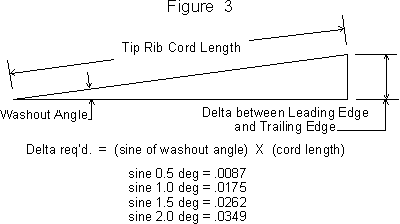Washout
By: Roy Vaillancourt
Over the years I have had many of my fellow modellers ask me about washout. What is it and how is it achieved and why do we use it? The easiest way to think about washout is to consider it a "built in twist" into the structure of a wing. A controlled warp if you will. Normally we would try to build things as straight as possible. Especially when it comes to wings. In aerobatic models that is most certainly the case, as we would like the model to behave the same whether it is upright or inverted. Aerobatic models are aerobatic by the very fact that they are designed to be inherently unstable or right on the "hairy edge". Hence, any means of establishing inherent stability is generally not used so it is not uncommon to see aerobatic models not use washout. Scale models on the other hand have a great desire to want to be stable so that the pilot in command stays calmly in command. One of the most popular means of building in some stability is to incorporate washout into the construction of the wings outer panels. Some designers apply washout to only the last few ribs on the outboard end of each wing panel. The better approach is to incorporate a varying amount of washout from root to tip of the "outer" panel. For example: Aircraft that have wings that are made up of multiple segments should have wash out only on the outer panels of the wing. Some examples would be a Corsair, Typhoon, Stuka, Hurricane or Hellcat etc. Aircraft with "complete" wing panels such as a Mustang, Spitfire, ME-109, FW-190 etc. should have washout incorporated in the entire panel from the aircraft centerline right to the tip rib."What is washout really, and how does it work?" you may ask.
Washout works like this: If a wing panel is twisted so that the trailing edge of the tip rib is slightly higher then the trailing edge of the root rib this will in effect reduce the angle of attack of the tip ribs. If this twist is gradual from the root of the panel to the tip each rib in this panel will progressively have a reduced angle of attack. This means that in flight as the airflow approaches the tip of the wing the tip ribs will stall later then the ribs closer to the root. This is good, as this will prevent "tip stall" at slower speeds when the angle of attack is generally higher then normal flight. This will help prevent the plane from snap rolling when you least want it. Like on landing approaches and slow fly-bys.
Washout should be "built in" to the wing structure during construction. This will insure that each wing panel has the same degree of washout and that it will be permanent. Some modellers will complete the wing and then attempt to add washout by "stressing" the skin to achieve washout. These techniques sometimes require the wing to be soaked with water or ammonia in the case of sheeted wings. Then twisted and held in place until everything dries. If the wing is an open frame work structure heat is applied to the covering and the wing is twisted to the shape desired. Both of these methods are not a "sure thing". Soaked wings never twist the same for each panel. Shrink fabric covered panels can change twist as the temperature at the flying field changes, especially if you live in one of the hot areas of the country like Florida or Arizona. The best method to insure permanent and accurate washout is to build it in right from the start. How do we do this? Pretty simple really. First we must start by doing a little drawing.
 On each rib draw a centerline
that runs from the center of the leading edge to the point of the trailing
edge, (see fig. 1). This is the line that the true incidence angles can be
measured from. Draw this line on every rib. Next we lay down the main spar
for the required panel right on the plans. Place the root rib of the panel
on the main spar and hold in place with a few pins or weights. Do not glue
yet. Next, place the tip rib on the spar and also hold in place. Again
do not glue. Taking an "extra" piece of spar material to act as a shim,
slide this under the trailing edges of the root and tip ribs. Now here is
the tricky part. At the root rib we want to measure from the rib's centerline
to the tabletop. Measure at both the leading edge and the trailing edge.
With the rib resting on the table at the main spar and resting on the "shim"
near the trailing edge we want these two measurements to be the same. Slide
the "shim" in or out to achieve this condition.
On each rib draw a centerline
that runs from the center of the leading edge to the point of the trailing
edge, (see fig. 1). This is the line that the true incidence angles can be
measured from. Draw this line on every rib. Next we lay down the main spar
for the required panel right on the plans. Place the root rib of the panel
on the main spar and hold in place with a few pins or weights. Do not glue
yet. Next, place the tip rib on the spar and also hold in place. Again
do not glue. Taking an "extra" piece of spar material to act as a shim,
slide this under the trailing edges of the root and tip ribs. Now here is
the tricky part. At the root rib we want to measure from the rib's centerline
to the tabletop. Measure at both the leading edge and the trailing edge.
With the rib resting on the table at the main spar and resting on the "shim"
near the trailing edge we want these two measurements to be the same. Slide
the "shim" in or out to achieve this condition.
 This will establish the previously drawn centerline to be parallel to the
tabletop, and the root rib will have zero incidence relative to the tabletop,
(see fig. 2). Mark on the plans under the root rib where this shim
needs to be to achieve this. Next, move out to the tip rib and repeat the
measurement steps. Naturally these numbers will be different than those
at the root rib, as the tip rib is generally smaller then the root ribs.
But, what we want here is to have this rib at a negative incidence angle
relative to the root rib. Negative incidence means that the leading edge
will be lower then the trailing edge. Or in other words, the trailing edge
is higher then the leading edge. How much higher will depend on the incidence
angle we need here. This negative incidence angle at the tip rib will be
our washout angle. Generally we would like at least 1 degree, but sometimes
up to 2 ½ degrees, depending on the type of plane, but never more
than the incidence angle that the root rib should have when the wing is installed
in the plane.
This will establish the previously drawn centerline to be parallel to the
tabletop, and the root rib will have zero incidence relative to the tabletop,
(see fig. 2). Mark on the plans under the root rib where this shim
needs to be to achieve this. Next, move out to the tip rib and repeat the
measurement steps. Naturally these numbers will be different than those
at the root rib, as the tip rib is generally smaller then the root ribs.
But, what we want here is to have this rib at a negative incidence angle
relative to the root rib. Negative incidence means that the leading edge
will be lower then the trailing edge. Or in other words, the trailing edge
is higher then the leading edge. How much higher will depend on the incidence
angle we need here. This negative incidence angle at the tip rib will be
our washout angle. Generally we would like at least 1 degree, but sometimes
up to 2 ½ degrees, depending on the type of plane, but never more
than the incidence angle that the root rib should have when the wing is installed
in the plane.
There are two easy ways to
measure this washout angle. The easiest is to use an incidence meter. The
other is to do a little trigonometry, where the "delta" between the leading
edge measurement and the trailing edge measurement will determine the washout
angle, (see fig. 3). Move the trailing edge shim in or out to achieve the
proper negative angle. Again, mark this location on the plans.
Once your shim is in place you can load the rest of the ribs and you'll
get an automatic built in twist to the wing panel from the root rib to the
tip rib. Once the top spar is added you can progress with all the other
wing structure stuff. Duplicate this procedure for the other panel and you'll
be assured that both panels are identical and permanent in holding the washout
angle. You'll find that once you get going, this procedure is relatively
simple and can be applied to many wing configurations. The beauty of this
technique is that it does not require any fancy jigs or alignment tools and
will produce consistent and accurate wing panels.
Move the trailing edge shim in or out to achieve the
proper negative angle. Again, mark this location on the plans.
Once your shim is in place you can load the rest of the ribs and you'll
get an automatic built in twist to the wing panel from the root rib to the
tip rib. Once the top spar is added you can progress with all the other
wing structure stuff. Duplicate this procedure for the other panel and you'll
be assured that both panels are identical and permanent in holding the washout
angle. You'll find that once you get going, this procedure is relatively
simple and can be applied to many wing configurations. The beauty of this
technique is that it does not require any fancy jigs or alignment tools and
will produce consistent and accurate wing panels.
If you haven't used washout before, and have had a few birds "drop out of the sky" in slow flight, give "washout" a try on your next project. You'll find the plane more manageable on landings, and you'll keep your plane longer……. Using washout will help prevent you from getting "washed out"…….
Good luck and happy flying.
Vailly Aviation 18 Oakdale Ave. Farmingville, NY, USA 11738-2828 Phone: 631-732-4715 after 7:00 P.M. www.vaillyaviation.com
New figures and editing done by Paul Battenberg
(copyright © 2000-2012 - RCFCT)
 Radio Control Flying Club of Toronto
Radio Control Flying Club of Toronto